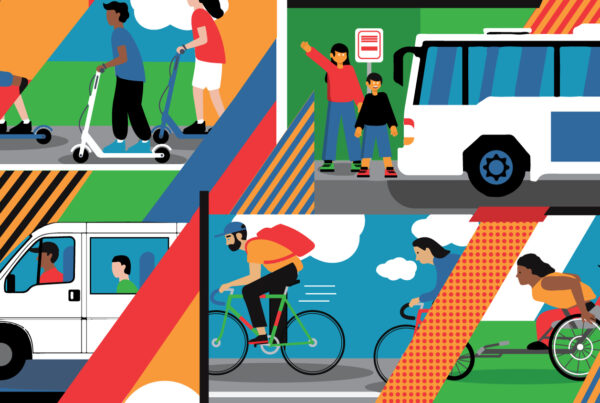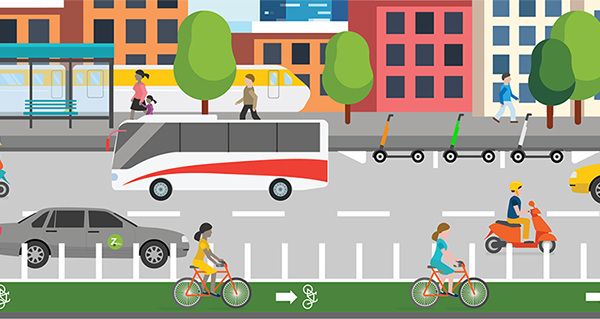With spring finally here, bikesharing systems like Nice Ride Minnesota and Boston’s Hubway are shaking off the snow and welcoming riders back for the 2015 season. For the bikesharing industry as a whole, however, there’s a lot more on the horizon than just warmer weather.
Important issues such as funding and equity are poised to come to the fore this year as the industry continues to grow and evolve. While the outlook seems to be mostly sunny from our vantage point, here are five bikesharing trends – both promising and troubling – to watch in 2015:
1. P2P bikesharing reinvents itself. Peer-to-peer (P2P) bikesharing, which allows individuals to rent out their bikes when not in use, is an interesting concept that hasn’t quite caught on. Earlier this year, however, leading P2P provider Spinlister announced a new business model that will use P2P bikesharing as a way to help people finance the purchase of a new bike.
Spinlister and Dutch company Vanmoof will partner together to manufacture handsome, high-quality bikes – set to roll out in Portland late this summer – with built-in technology like Bluetooth-enabled locks that are specifically designed for use in P2P networks. Members can purchase the bikes from Spinlister and then pay for them over time using rental revenue.
2. The big get bigger. The country’s biggest bikesharing systems, including Citi Bike in New York and Divvy in Chicago, have announced plans for major expansion over the next several years. This spring, Chicago will be growing its system to 476 stations and 4,760 bikes. Citi Bike will add 90 new stations by the end of 2015, and expects to have more than 700 stations and 12,000 bikes by the end of 2017. On the west coast, a proposal was announced recently to expand Bay Area Bike Share tenfold, from 700 to 7,000 bikes. Additionally, small and mid-size cities like Seattle and Indianapolis are also growing successful bikesharing systems of their own.
3. Look mom, no docks. The industry has been closely following the progress of up-and-comer Social Bicycles, which is pioneering a new model of bikesharing that puts GPS technology directly in its bikes, rather than in smart docks or stations. With SoBi’s model, riders are free to park their bikes anywhere within a geo-fenced area using built-in locks. Other users can then find the bikes using a web-based app, similar to one-way carsharing.
The model requires much less infrastructure than traditional bikesharing systems, and the tech-enabled bikes can provide data on miles traveled, calories burned, CO2 reduced and more. SoBi is currently operating in several North American cities including Phoenix, Orlando and Buffalo, New York.
4. Funding issues continue. Despite the industry’s momentum, some cities have still struggled to adequately finance bikesharing. Most recently, the news about the dire financial straits of San Antonio Bike Share captured significant attention. As is common, the system’s bikesharing operations are run by a nonprofit while a private company services the bikes and stations. Unlike other systems, however, San Antonio Bike Share does not receive local government funding or have a corporate sponsor.
Many have observed that bikesharing seems to be caught in a gray area between public transportation and private industry, and have called for a better long-term funding solution. Recently, transportation advocates have sought to push the message that bikesharing is transit, and deserves to be publicly subsidized just like trains, buses and any other form of public transportation.
5. Increased focus on Equity. Analysis of a recent member survey by Washington, D.C.’s Capital Bikesharing revealed that half of survey respondents reported an annual income of $100,000 or more. The story further underscored criticism that bikesharing has largely failed to reach low-income residents. Fortunately, it looks like the industry will be making some major headway in addressing equity issues in 2015.
Philadelphia’s new Indego bikesharing program, which launched in late April, has an especially strong equity component. One third of the 600 bikes in the Indego system will be located in low-income neighborhoods, and all residents will have the option of paying with cash if they don’t have access to a credit card or bank account. Philadelphia will also be hiring specially trained neighborhood ambassadors to engage residents and show them how to use bikeshare.
Chicago recently launched a new Divvy for Everyone (D4E) program focused on increasing Divvy’s availability to low-income communities and unbanked residents. With help from a grant by the Better Bikeshare Partnership, D4E will provide discounted annual memberships for qualified applicants. The program will also feature additional citywide outreach in partnership with several community organizations.
Addressing these remaining challenges is important because bikesharing has the ability to play a vital role in providing first/last mile solutions and boosting connectivity within transit systems, in addition to obvious environmental benefits. In the coming months, SUMC will be interviewing officials at transit agencies throughout the nation to compile best practices for integrating existing transit systems with shared mobility. We hope to have more insights to share soon!
Photo by Tony Webster



